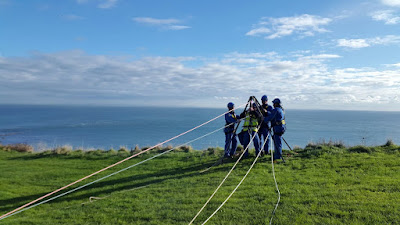When we arrive at a rescue, a holdfast will be set up (consisting of two or more stakes driven into the ground as an anchor point for a safety rope) to allow an Edge Safety Officer to get to the edge of the cliff safely. The ESO will try to make visual or verbal contact with the casualty and will assess the situation and report back to the Officer in Charge (OIC) and Rope Technician who will then decide how the rescue is to be achieved.
The ESOs (we deploy two) are the key link between the technician and casualty at the bottom of the cliff and the team of Rope Operators at the top of the cliff. Their role includes:
- identifying, monitoring and reassuring the casualty
- reporting back key information to the cliff top team
- installing the 'quadpod' to ease the route of the ropes over the cliff edge
- final safety checks on the Rope Technician before deployment (there will have already been initial checks on the cliff top)
- assistance to the technician getting over the edge and identification of any loose rocks, ledges or other difficulties that he may encounter on the way down.
- relaying information between the operators and the technician and controlling the operation by voice, radio, hand signals or whistle signals
- assistance to the technician in returning a casualty to the cliff top (eg helping with the stretcher as it comes over the top.
- ensuring the technician and casualty are securely back in the safety zone before the recovery is considered completed and the lines are locked off.
The Edge Safety Officer should be an approved Rope Technician so that he (or she!) has the skills to advise / assist the technician and can take over if the need should ever arise.
 |
| ESOs check and assist the rope technician as he goes over the cliff edge |
 |
| The view the Rope Operators get. In this case the signals - a winding motion upwards - are to take in the lines |

No comments:
Post a Comment